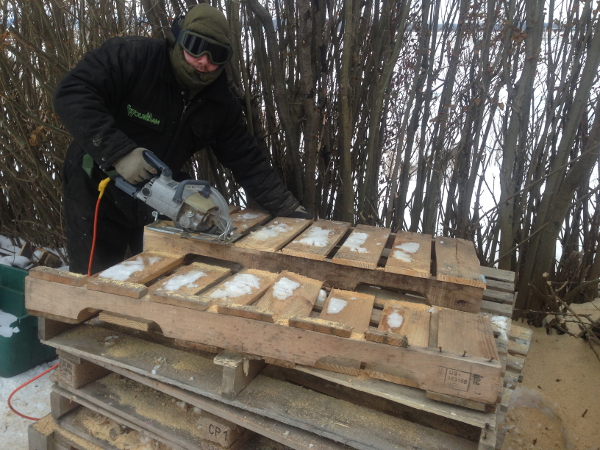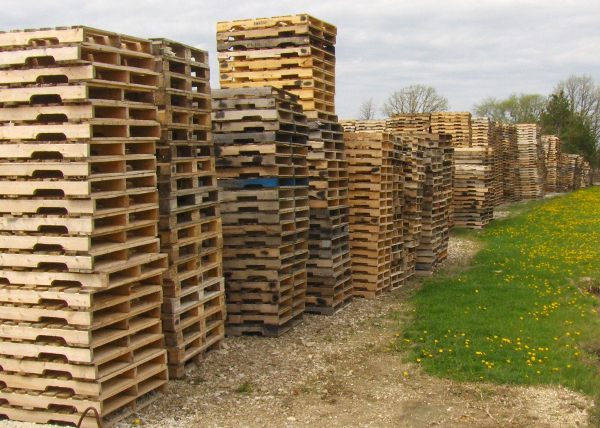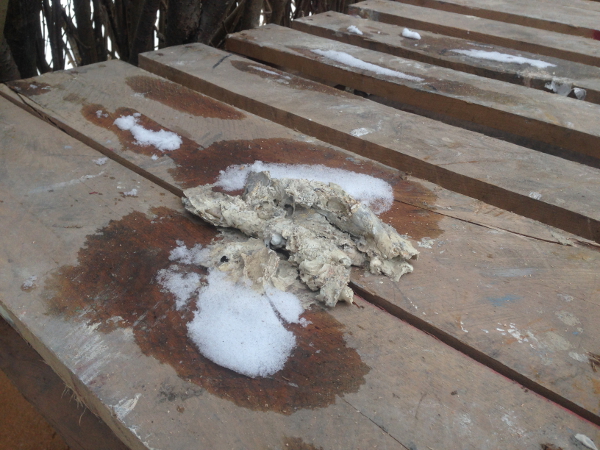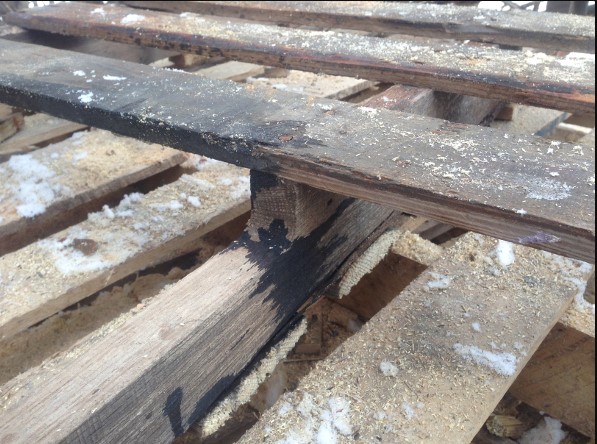
Each winter, for those who live in cold temperatures, and in remote locations – houses have to be heated. Many country houses (especially in Canada) are heated one of two ways. Oil, which can be extremely expensive, or wood, which can be moderately expensive.
At the time this article was written, filling a 1,000L would cost almost $1,500.00 and can sometimes only last a couple of weeks!
A less expensive alternative to oil, is to heat your winter abode with wood. At the time of this writing, wood can also be somewhat costly at around $80.00CAD a cord.
Imagine if there was a cheaper way – a way to help the environment, help your local businesses and heat your home or cabin for FREE during the cold months.
SKIDS Many people do not realise, that there every day, millions of businesses around the world are inundated with large amounts of wooden skids. Each tractor trailer can hold up to 26 wooden skids.
A few years ago, all of these wooden skids (sometimes known as pallets) would have been destined for landfills. New legislation outlawed putting skids into landfills in North America.
Businesses now have to either pay to have companies remove skids off the property and recycle them, or let them pile up in massive yards the size of a city block, in hopes someone comes along and wants them.

This is where you come in. Companies are often actively seeking people to haul away their old skids. Some people have made businesses of collecting skids for free, breaking them up, than selling the lumber. All you need is a way to get them from the business to your work space. A pick-up truck, or Jeep with a trailer are both great ways to collect skids.
Skids are often made of some of the highest quality, exotic hard woods that belong in furniture and flooring rather than industrial waste. You will often find skids made of Ash, Beech, Mahogany, and Oak. The author even once had an entire skid made of Purple Heart, an exotic hard wood from Mexico.
CHOOSING SKIDS Although it is easy to get excited when you see hundreds upon hundreds of discarded skids and think “Jackpot!” It’s important to be careful when choosing skids to burn indoors and be mindful of their source.
Skids are designed to transport freight. This could be anything from boxes of bathroom tissue, discarded paints, to radioactive materials.
Inspect each skid and ensure that there are no phantom stains, odd smells, and obvious signs that the skid is contaminated. Avoid skids made of plastic, or pressure treated wood. Remember that you will be breathing in the vapours of whatever it is you burn. Even the most modern, sealed woodstove will release gases which you will breathe in when burning wood in your home or cabin. You certainly do not want to be breathing in tars, paints, or other things which are best left alone.

The skid above is an example of some form of industrial waste material (possibly old paint, or plastics) which you would want to avoid putting in your fireplace or wood stove. There is no telling what this material is, or what it could do if you inhaled it.
 The skid pictured above is typical of the kind of mystery stains that can appear on skids. This skid, once processed revealed some kind of tar, oil, or other undesirable material has come in contact with it.
Be sure the skids you select are marked with HT, and not some other letters. This ensures that your skids are Heat Treated instead of chemically treated. Heat Treated skids are designed to keep creepy-crawlies out of the wood (and your home) and do not contain any chemicals which you would not want to be exposed to.
BREAKING SKIDS
Once you have a supply of skids that are suitable for breaking, you can begin the process of cutting the skids up and processing them for use in your home or cabin. There are a couple of tools you need, which will take almost all of the labour out of the process. You don’t need pry bars, hammers, or hand-saws.
Skill Saw: Buy the cheapest of cheap blades, as you will go through them very quickly. Often 2 or 3 blades a month depending on how many skids you use. From the authors experience, there is no difference between cheap blades, and expensive blades when you are breaking skids. The blade needs to rip through various kinds of hard and soft woods as quickly as possible. It is not necessary to have a clean cut.
Mitre Saw: This is an optional tool, but will save your Skill Saw and your arms. You will use the Mitre Saw to rip through the larger 38mm x 89mm pieces which are left over when you cut the planks.
The following video is how the author rips skids. After decades of experience, this is the most efficient way he has found to get the job done quickly.
The skid pictured above is typical of the kind of mystery stains that can appear on skids. This skid, once processed revealed some kind of tar, oil, or other undesirable material has come in contact with it.
Be sure the skids you select are marked with HT, and not some other letters. This ensures that your skids are Heat Treated instead of chemically treated. Heat Treated skids are designed to keep creepy-crawlies out of the wood (and your home) and do not contain any chemicals which you would not want to be exposed to.
BREAKING SKIDS
Once you have a supply of skids that are suitable for breaking, you can begin the process of cutting the skids up and processing them for use in your home or cabin. There are a couple of tools you need, which will take almost all of the labour out of the process. You don’t need pry bars, hammers, or hand-saws.
Skill Saw: Buy the cheapest of cheap blades, as you will go through them very quickly. Often 2 or 3 blades a month depending on how many skids you use. From the authors experience, there is no difference between cheap blades, and expensive blades when you are breaking skids. The blade needs to rip through various kinds of hard and soft woods as quickly as possible. It is not necessary to have a clean cut.
Mitre Saw: This is an optional tool, but will save your Skill Saw and your arms. You will use the Mitre Saw to rip through the larger 38mm x 89mm pieces which are left over when you cut the planks.
The following video is how the author rips skids. After decades of experience, this is the most efficient way he has found to get the job done quickly.
Barefoot Bushcraft acknowledges the land on which we gather was the historic territory of the Haudenosaunee and Anishinaabe peoples, many of whom continue to live and work here today. This territory is covered by the Upper Canada Treaties and is within the land protected by the Dish With One Spoon Wampum agreement. Today this gathering place is home to many First Nations, Métis, and Inuit peoples and acknowledging reminds us that our great standard of living is directly related to the resources and friendship of Indigenous peoples.
Error: Contact form not found.
Error: Contact form not found.
Error: Contact form not found.
Error: Contact form not found.
Error: Contact form not found.
Error: Contact form not found.
Error: Contact form not found.
Error: Contact form not found.